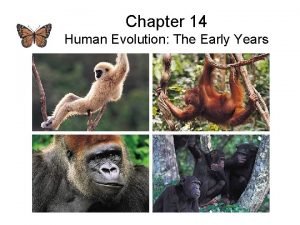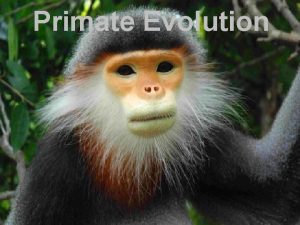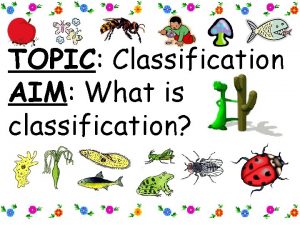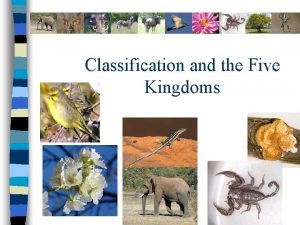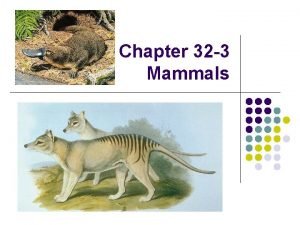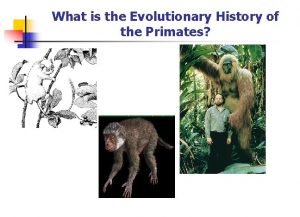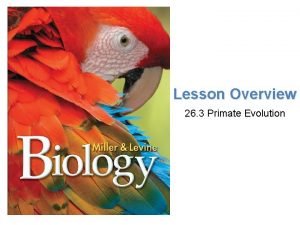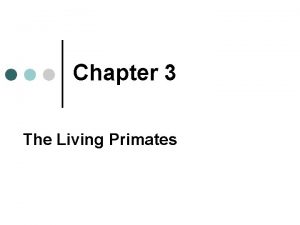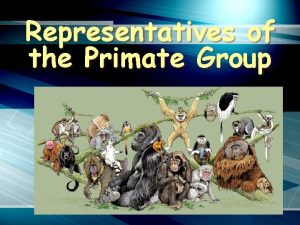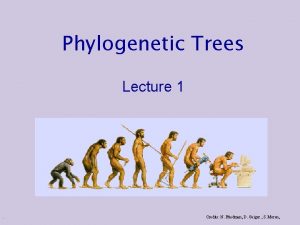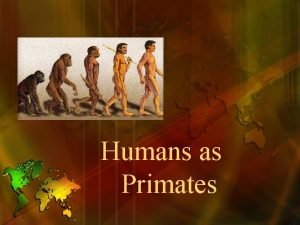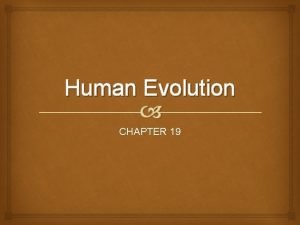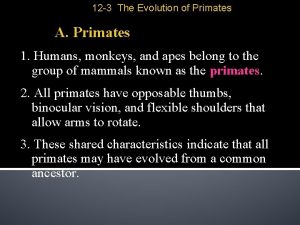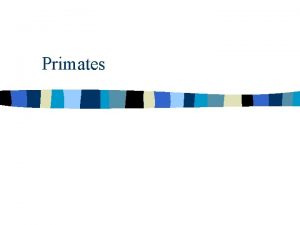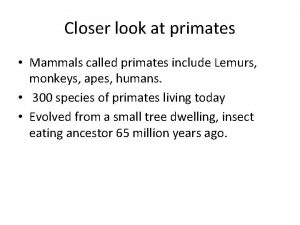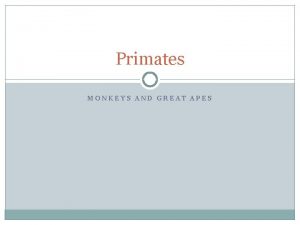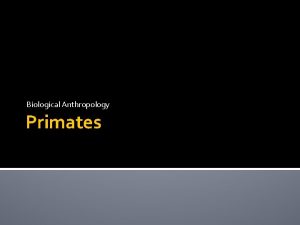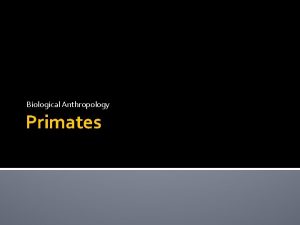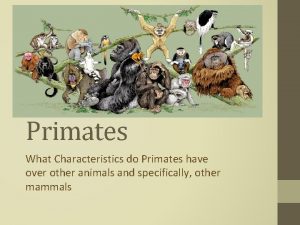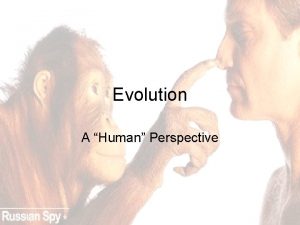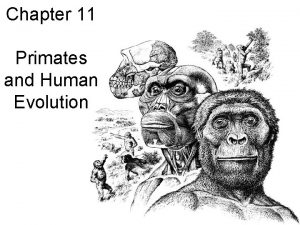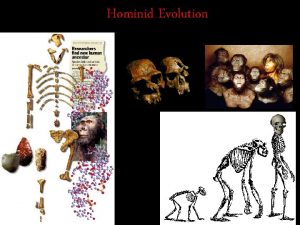Chapter 14 Human Evolution The Early Years Primates




















- Slides: 20

Chapter 14 Human Evolution: The Early Years

Primates have grasping hands, a method of navigation referred to as brachiation. Primates have nails, not claws or hooves. Primates have stereoscopic vision, wherein the two eyes scan an overlapping part of the visual field before them. This improves the precision of depth perception. When a monkey moves from branch to branch; reliable depth perception is crucial, to judge the distance and safely reach the next branch. Primates have relatively large brains.

圖片所屬網頁 http: //www. island 4 x 4. com/ 所屬網頁 http: //www. shadowsquirrel. de/gallery_2/ primates evolved about 65 million years ago, just as the last of the dinosaurs were flickering out. About 40 million years ago, these early primates split into two surviving groups-the prosimians and anthropoids. The prosimians (basal primates) large eyes serve them well in their mostly nocturnal lifestyles.

• Primates are divided into two subgroups. – The Prosimii (prosimians), probably resemble early arboreal primates and include the lemurs of Madagascar and the lorises, pottos, and tarsiers of tropical Africa and southern Asia. – The Anthropoidea (anthropoids) include moneys, apes, and humans. Copyright © 2002 Pearson Education, Inc. , publishing as Benjamin Cummings

The anthropoids; platyrrhines -- about 30 million years ago, some early anthropoids made it to South America ( how is still not known). Another group of anthropoids, the catarrhines, is African in origin.

Table 14. 1 Classification of Primates prehensile tails and Nostrils open to the side

FIGURE 14. 5 Primate Relationships • Primates divide traditionally into two major groups. The prosimians tend to be small and nocturnal, including bush babies of Africa, the lemurs of Madagascar, and lorises and tarsiers of Southeast Asia. The anthropoids are more derived, including monkeys plus gibbons, apes, and hominids.

• In addition to monkeys, the anthropoid suborder also includes four genera of apes: Hylobates (gibbons), Pongo (orangutans, Gorilla (gorillas), and Pan (chimpanzees and bonobos)--Modern apes are confined exclusively to the tropical regions of the Old World. Fig. 34. 37 Copyright © 2002 Pearson Education, Inc. , publishing as Benjamin Cummings

The Course of Hominid Evolution Fossils, together with molecular structures, pointed to a hominid divergence from chimpanzees at around 7 million years ago. These oldest hominids date to between 6 and 7 MYA. Sahelanthropus tchadensis from a nearly complete skull; Orrorin tugenensis consists of pieces of arm, thigh, and jawbones, several teeth 人類從黑星星演變來

The Course of Hominid Evolution S. tchadensis has a relatively small brain (chimp-like) but brow ridges and small canine teeth (hominid-like). The mixture of features, fits expectations of being close to the common ancestor of Chip. and Hum. from a nearly complete skull; O. tugenensis Advocates promote one or both of these fossils as common ancestors 人類從黑星星演變來 to chimps and hominids.

The Course of Hominid Evolution Ardipithecus ramidus lived almost 4. 5 million years ago, in Africa. Australopithecus anamensis soon followed, 4. 2 to 3. 9 million years ago. The robust hominid line, the gracile hominid line

Hominid relationships • Hominids generally evolved in two directions. One, a “robust” line that became extinct about 1 million years ago. • The other, is the “gracile” line continuing down to modern Homo sapiens.

Ape and hominid skeletons • Respectively, the backbone joins the back of the skull or bottom. The backbone is arched or S-shaped. The arms are long in both, but shorter than hindlimbs in the ape compared to the hominid. The hips are long or bowl-shaped and the femur (upper leg bone) is angled out or in.

Bipedalism • Walking comfortably on two hindlegs, bipedalism, evolved early in hominids. Many of the changes in body design and eventually in social systems derive in part from this fundamental change in posture. Some of the major branches in hominid evolution are shown.

• In hominids, the upright, bipedal posture is Bipedal adaptations I derived from primates that are dependent upon a four-footed, quadrupedal posture. Such upright carriage of the body poses special problems in engineering. To accommodate this posture and stabilize it, the hominid gluteus muscles are large (balance leg swing), hips are wide (broad support), the spine curved (centers body weight, shock absorbing), and the position of the spine is beneath the skull (accommodate erect stance). (see also Bipedal adaptations II)

Bipedal adaptations II • Further adaptations (see also Bipedal adaptations II) to bipedalism include a change of the big toe (hallux) from grasping in apes to striding in hominids, repositioning of the hominid knee more under the pelvis, and shortening of the hips to a broader base of support of the upper body.

Australopithecus africanus 所屬網頁 http: //www. gilde-der-kosmischen-former. de/

圖片所屬網頁 http: //www. marinedice. com/

Australopithecus africanus A. afarensis Homo habilis Homo erectus 圖片所屬網頁 http: //www. icb. ufmg. br/~lbem/aulas/grad/evol/

Locomotion Other features: Large brains; a hair coat; reduced; complex sentence
 First years
First years Evolution of primate
Evolution of primate Sheep years to human years
Sheep years to human years Chapter 16 primate evolution assessment answer key
Chapter 16 primate evolution assessment answer key 300 solar years to lunar years
300 solar years to lunar years Four score and twenty years ago
Four score and twenty years ago Primate taxonomy upsc anthropology
Primate taxonomy upsc anthropology Canis lupus genus
Canis lupus genus Old world monkeys vs new world monkeys
Old world monkeys vs new world monkeys Animal pyramid kingdom
Animal pyramid kingdom Order primates
Order primates Purgatorius
Purgatorius Primates
Primates Primates
Primates Espacios primates odontopediatria
Espacios primates odontopediatria Primates
Primates Prosimii
Prosimii Primates characteristics
Primates characteristics Primate tree
Primate tree What are primates
What are primates Human evolution
Human evolution
